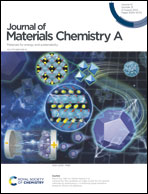Rational design of the FeS2/NiS2 heterojunction interface structure to enhance the oxygen electrocatalytic performance for zinc–air batteries†
Abstract
Fine design of nanostructures of bifunctional electrocatalysts and developing low-cost, efficient and durable electrocatalytic materials are important directions for the development of sustainable energy storage and conversion devices such as electrolytic water and metal–air batteries. In this work, nickel–iron layered sulfide hollow double-shell nanorods were synthesized by a one-step hydrothermal self-templating process followed by a high-temperature sulfurization process. Benefiting from the large electrochemically active surface area of the layered nanosheets, the electronic regulation of the FeS2/NiS2 heterogeneous interface, and the mechanical support of the hollow core–shell structured nanorods, the synthesized FeS2/NiS2 hollow multi-shell nanorods with an open layered array structure (FeS2/NiS2 HDSNRs) show better electrocatalytic performance than the single component FeS2 and NiS2 electrocatalysts in alkaline electrolyte solution. In 1.0 M KOH solution for the oxygen reduction reaction, the FeS2/NiS2 HDSNRs electrocatalyst has a half-wave potential of 0.80 V vs. RHE and an overpotential of only 280 mV at a current density of 50 mA cm−2 for oxygen evolution reaction and the Tafel slope is only 33 mV dec−1. The FeS2/NiS2 HDSNRs electrocatalyst used as the cathode of a liquid zinc–air battery showed a peak power density of 130 mW cm−2 and a charge–discharge cycle life of 480 h at a current density of 5 mA cm−2, with a voltage gap of only 0.92 V. In addition, the assembled solid-state zinc–air battery also exhibits a charge–discharge cycle life of 11 h at a current density of 5 mA cm−2, and two solid-state batteries connected in series can also drive LED lights. This study provides new insights for the rational design of nickel–iron sulfides with a layered nanosheet-core–shell structure for electrocatalysis and renewable energy applications.



 Please wait while we load your content...
Please wait while we load your content...